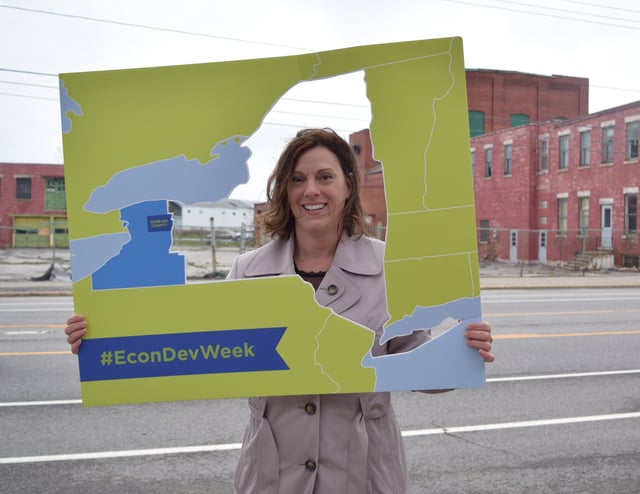Nestled in between the bustle of Buffalo and the city of Rochester lies Batavia, New York. The strategic geographic location lends Batavia to a surprising number of visitors and passerbys. The city streets see nearly 25,000 cars a day, which help local businesses and is part of the reason for the burgeoning renaissance of Batavia.
Plans are in place for a new Batavia. One with walkable city streets, affordable apartments, plentiful jobs, and entertainment to grip people’s attention.
“It’s about making energy radiate from the city core,” said Julie Pacatte, economic development coordinator for Batavia Development Corporation.
A significant part of the plan is the Batavia brownfield opportunity area. The area consists of five brownfield sites ready for redevelopment and a fresh start.
The most promising among them: Ellicott Station. The site, formerly named Della Penna, has a development agreement with Savarino Companies. The development plans for a complete overhaul of the property.
Part of the existing building will remain, through renovations, and become a new Resurgence Brewing Company site. Resurgence plans to produce sour beers in the facility to avoid contamination in their original spot in Buffalo. A tasting room, beer garden, full kitchen, and event space are in the plans. Resurgence is expected to be open in Batavia next summer.
 Julie Pacatte pictured in front of Ellicott Station.
Julie Pacatte pictured in front of Ellicott Station.
The remaining part of the building will be demolished and reconstructed. That space will contain market rate apartments. It will be a five-story building with covered parking on the ground floor. Class A office space will also be constructed. The jobs at Ellicott Station is something the site hasn’t seen in quite some time.
“This site has not seen 60 jobs in nearly a century,” Pacatte said. The entire project will cost nearly $18 million. It’s a testament to both Batavia’s future and the recent success of other mixed use projects by which Ellicott Station’s future is inspired.
“Selective demolition and adaptive reuse creating a mixed-use campus,” Pacatte said.
Some other brownfield sites have great potential in Batavia, as well. The Healthy Living Campus sits right next to the local YMCA. Those two sites have had healthy discussions about the possibilities of a new YMCA and a general medical campus promoting healthy lifestyles on the site.
The Creek Park site is undergoing environmental research. The City Center site is more difficult to control (being a mall, there are dozens of stakeholders), but it is premium downtown acreage that would be ripe for a “patient developer,” said Pacatte.
Harvester Center, a 1 million sq. ft. site served by rail, has two concepts currently being considered. One involves an innovation zone with mixed use building creating a live, work, play atmosphere. The other would create a light industrial site. The current building is approximately 120,000 sq. ft.
Overall, Batavia is working to build its epicenter around the downtown corridor. Nearly 4,500 people that live in the city of Batavia leave each day to work. At the same time, of the 9,500 city jobs in Batavia, 7,400 are held by those that commute into the city every day.
The goal is to make the city of Batavia more livable. With the current vision, Batavia is well on its way.

